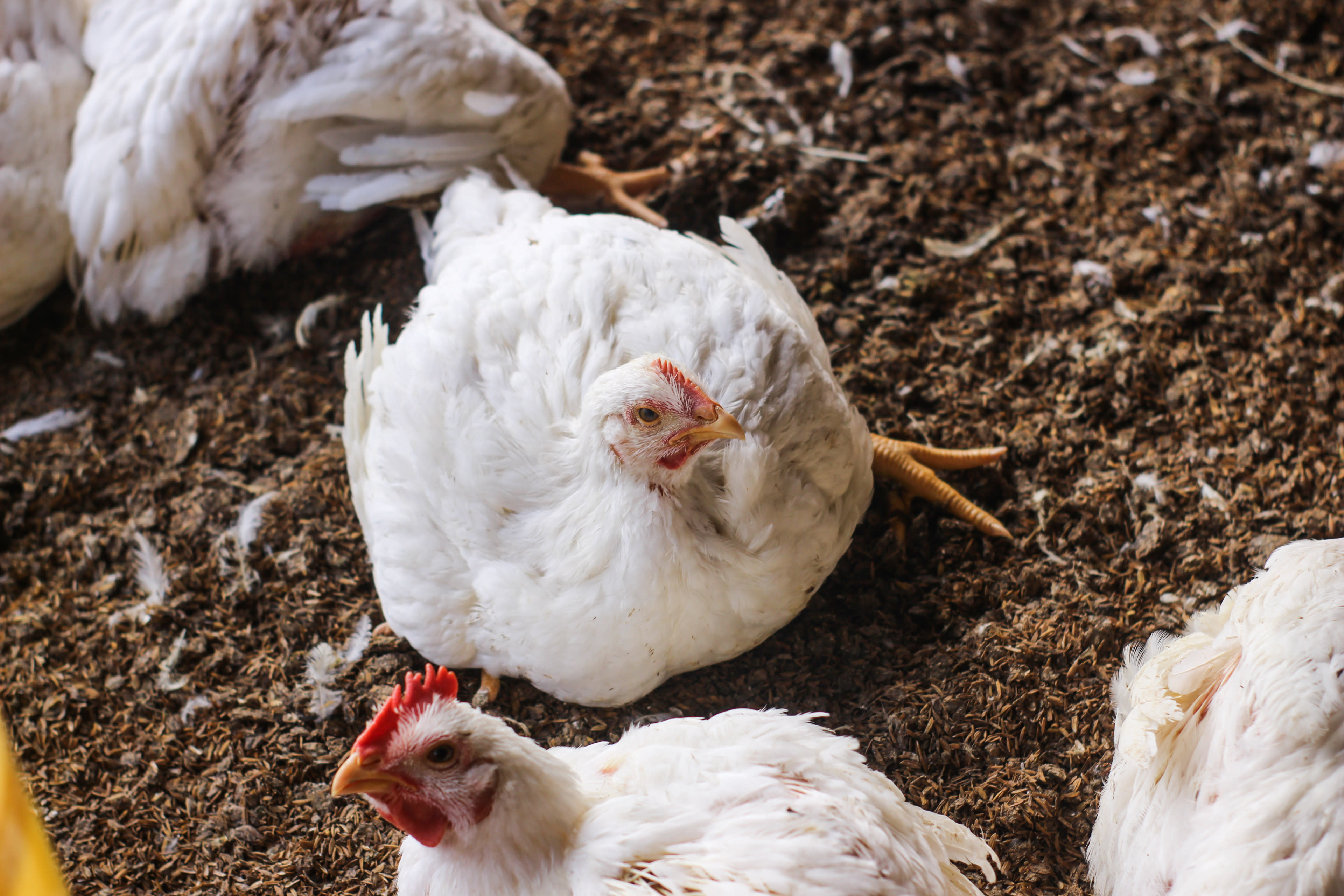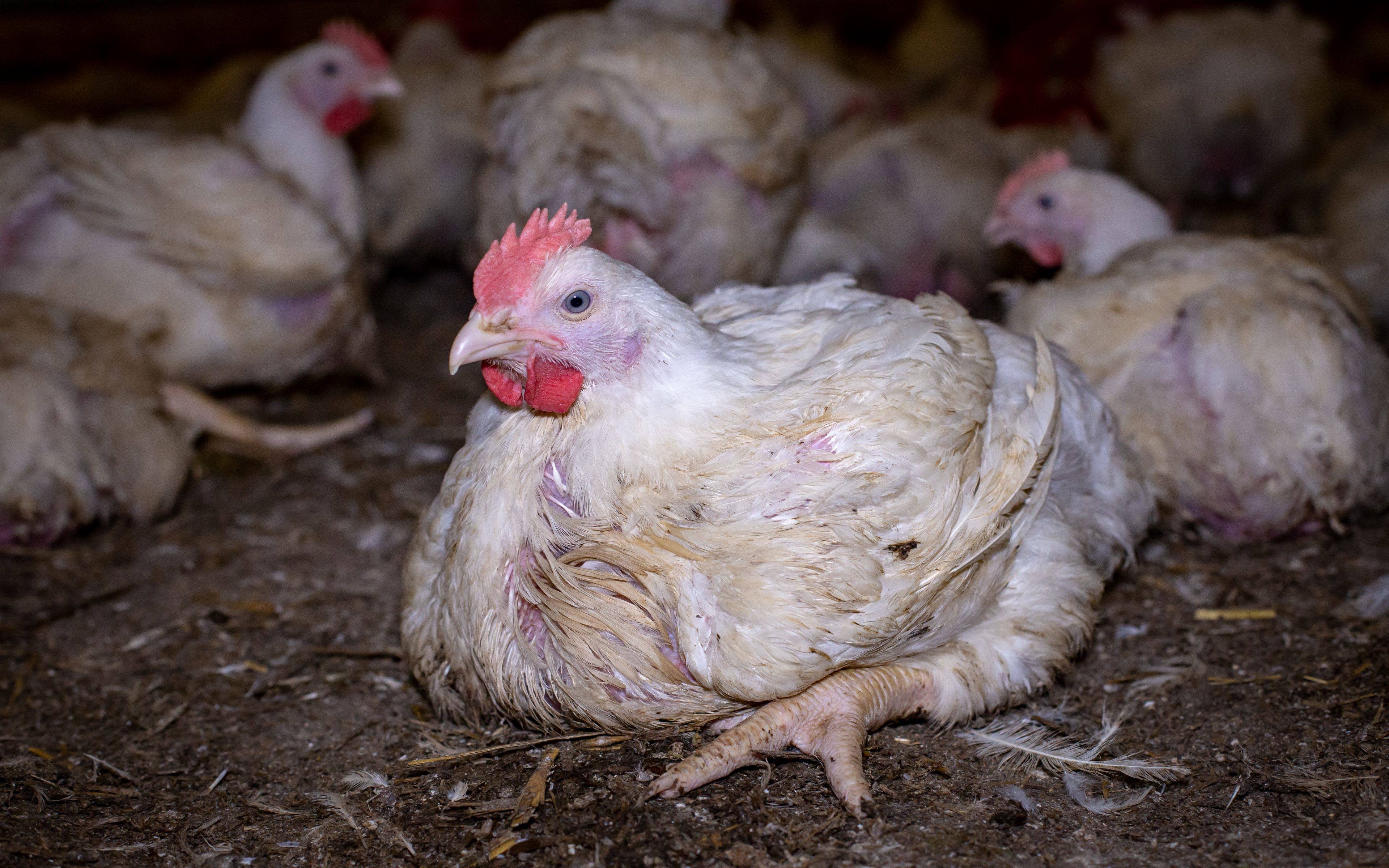




The use of antibiotics on chicken farms not only encourages chickens to grow unnaturally large, unnaturally fast—it also poses a grave threat to human health, in the form of growing antibiotic resistance.

Antibiotic drugs are crucial in the fight against deadly diseases, responsible for saving millions of lives around the world. Unfortunately, they’re also key to the existence of factory farms. Because without a steady flow of drugs, many animals would not survive the harrowing conditions inside these facilities.
While farm corporations claim antibiotics are necessary for the production of cheap meat, what’s really being cheapened is the value we place on life—both human and nonhuman. Drug use on factory farms is a leading cause of antibiotic resistance, a serious health threat facing humanity today.
Why do factory farms use chicken antibiotics?
In the wild, chickens live in small flocks often with only a handful of members, traversing a range of habitats as they forage for insects, seeds, and other food. Disease can lurk around every corner and beneath every leaf. Despite innumerable hidden threats, wild chickens can enjoy a lifespan of a decade or more, all without any intervention from human beings.
Life in the wild does not require the constant application of drugs: a fact that renders the woeful living conditions on factory farms all the more stark. Virtually all of the chicken meat consumed in the United States comes from factory farms, where birds are kept in extremely crowded and filthy indoor conditions, prevented from ever spending time outdoors or even seeing the sun through a window. Factory farms are the antithesis of natural living conditions for chickens.
Without antibiotics, raising chickens on factory farms would be extremely expensive—because the conditions on these farms are otherwise unlivable. Drugs are regularly administered via daily water and food rations and are generally used throughout the chicken’s lifetime, starting when chicks are only a few days old.
What do antibiotics do to chickens?
On factory farms, antibiotics are used for two reasons: to promote growth and to prevent or treat infection. They're administered regularly in the chickens' feed, and they're so effective at encouraging rapid growth that today's chickens are twice as large as chickens were 60 years ago. This is a problem because broiler chickens' bodies can't support this much weight. This unnatural growth leads to skeletal and joint issues, and it often causes so much stress on the chickens' legs that they become painfully lame.
The Better Chicken Commitment encourages companies to commit to purchasing chickens from suppliers that don't make use of rapid-growth breeds, among other welfare requirements. More than 200 companies have signed the commitment, including Burger King, Chipotle, Denny's, and Subway.
Which antibiotics are used on chickens?
There's a long list of antibiotics given to chickens, often in their daily food and water rations. The Poultry Extension provides a summary of some of the more popular antibiotics used in chicken production:
- Aminoglycosides (treat intestinal infections)
- Bambermycins (prevent the synthesis of the cell walls of bacteria)
- Beta-lactams (two types: penicillins and cephalosporins)
- Ionophores (prevent intestinal infections)
- Lincosamides (combat joint and bone infections)
- Macrolides (treat a fatal condition called necrotic enteritis, which is caused by overeating)
- Quinolones (broad-spectrum drugs that affect a wide range of bacteria)
- Streptogramins (prevent cell wall formation and protein synthesis, used to treat and prevent necrotic enteritis)
- Sulfonamides (prevent and combat Salmonella, E. coli, and other pathogens)
What are the dangers of antibiotics in chicken?
Unless you’re buying your chicken directly from a small farmer, it's extremely likely that the chicken on your plate is laced with antibiotics. While antibiotics are beneficial to the producer’s bottom line, they give rise to one of the greatest health threats the world has ever faced: antibiotic resistance.
Antibiotic resistance occurs when antibiotic drugs are given to an individual animal—including humans—and the drugs kill most, but not all, of the targeted bacteria responsible for the infection. The surviving bacteria then learn how to survive the drug, becoming resistant to its effects over time. Antibiotic resistance is particularly threatening to people and animals with compromised immune systems, whether from HIV/AIDS, cancer, or chronic inflammatory conditions.
The routine use of antibiotics causes antibiotic resistance in both farmed animals and the people who eat them. A report by the World Health Organization (WHO) in the summer of 2020 identified a growing list of infections that are becoming more difficult to treat, including tuberculosis, pneumonia, and gonorrhea. According to WHO, at least 700,000 people die each year from antibiotic-resistant infections—a number that could soar to 10 million by 2050.
Antibiotic resistance is a major contribution to the long list of harms that factory farms inflict on people, animals, and the environment. It provides further justification to close these facilities and repair our broken food system.
What does "antibiotic-free chicken" mean?
Antibiotic-free chicken labels indicate that antibiotics were not used during the bird’s life. However, different labels can mean different things. For example, a “raised without antibiotics” label means that no antibiotics were used even during the first few days of life, which is a common time for these drugs to be administered. Other common labels include “no medically important antibiotics,” which means no antibiotics that are commonly used to treat human beings, and “no growth-promoting antibiotics,” which indicates that antibiotics were not used to unnaturally encourage the chicken's growth.
How does the FDA regulate the use of poultry antibiotics?
The US Food and Drug Administration (FDA) is responsible for regulating the use of antibiotics in farmed animals, including poultry. Along with the USDA’s Food Safety and Inspection Service, the agency monitors meat and eggs for trace amounts of unapproved drugs.
Currently, the FDA is developing a framework for food producers to voluntarily stop using medically-important antibiotics for growth promotion. However, without strict mandatory regulations, these voluntary frameworks may not be effective in preventing widespread antibiotic resistance—since the financial incentives for farms to grow bigger chickens will likely outweigh any concern for human health.
What does the CDC say about antibiotic resistance?
The Centers for Disease Control and Prevention (CDC) support the judicious use of antibiotics in livestock. They have a section on their website dedicated to poultry producers and ways that the industry can combat antibiotic resistance. Their recommendations include keeping animals healthy, working closely with veterinarians, and using antibiotics exactly as they are prescribed.
What can I do for chickens?
Antibiotics enable the unnatural growth of billions of chickens every year. As they languish on factory farms, antibiotic resistance looms as a growing threat to human health worldwide. An effective way to take action against these threats is to withdraw support from the chicken industry by reducing or eliminating your consumption of these products. With the proliferation of plant-based alternatives to all types of chicken products, it's easier than ever to make the switch.
To advocate for better living conditions for chickens, take action with us.






